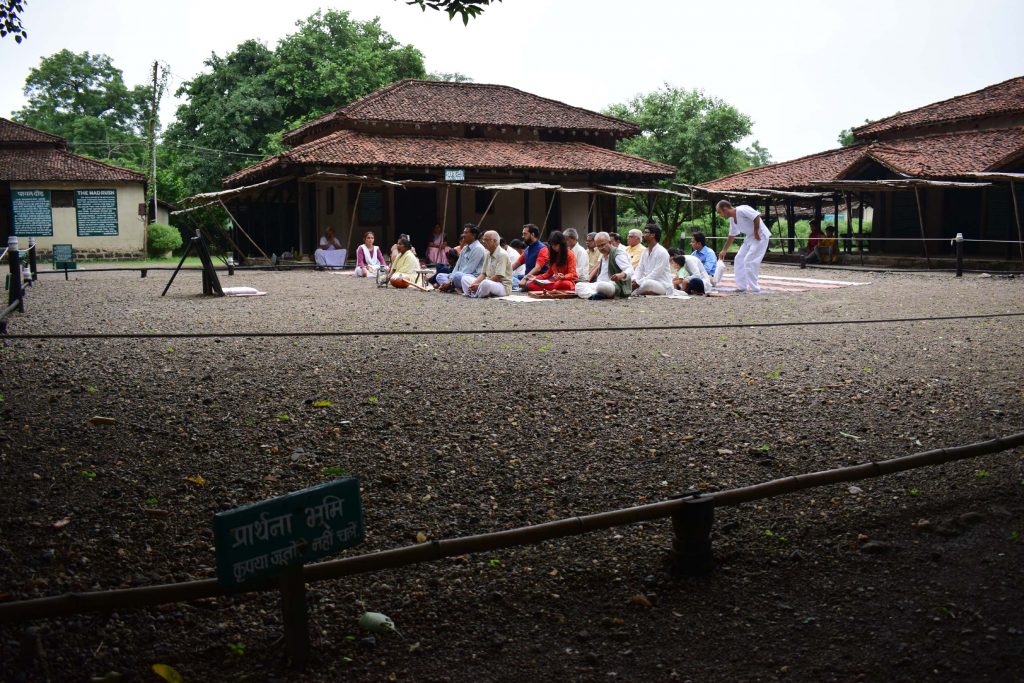Priya Ranjan Sahu
The hustle and bustle of Wardha fades as you drive towards Sevagram about 10 km from the city. The sleepy town houses Sevagram Ashram, founded by Mahatma Gandhi in 1936. The town has come up around the ashram, which is calmer than the surroundings.
Time seems to have stopped here since Gandhi left it in 1946 on a peace mission to quell communal riots in Nuakhali (now in Bangladesh) and never returned. Barring additions such as electricity and a few other unavoidable modern utilities, not much has changed at the ashram today.
It draws visitors by the lakhs each year. Most are curious and amazed at the sheer simplicity that the cluster of cottages surrounded by trees exudes. Gandhi, Kasturba and other freedom fighters lived in these cottages.
Gandhi spent the last and probably most fruitful decade of his life at Sevagram Ashram and it was one of the most important phases in the freedom movement. “At that time wherever Gandhi stayed became the unofficial capital of India,” Gandhian thinker Chinmay Mishra says. Gandhi left Sabarmati Ashram when he launched the salt satyagraha. The Dandi march that started March 12, 1930, from Ahmedabad and covered 390 km to the coastal place shook the British, who had imposed exorbitant tax on production of salt by locals and monopolised salt trade.
The news of Gandhi’s 24-day march to Dandi, spread like wildfire along the length and breadth of the country and invigorated the national disobedience movement. As Gandhi and his followers, who swelled by the day, continued making salt at different places along the coast, the British arrested and put him in the Yerawada Jail in Pune for a year.
Upon release, he moved around the country as he had decided not to return to Sabarmati until India got Independence. After covering more than 20,000 km campaigning against social evils such as discrimination against Dalits and the practice of untouchability, Gandhiji focused on making a place in central India as the nerve centre of the freedom movement. Wardha, now in Maharashtra, seemed ideal. Following an invitation from his trusted associate Jamnalal Bajaj, Gandhi first shifted to an estate (now known as Maganwadi) in Wardha owned by the former in 1934. Two years later, he founded an ashram in Segaon and named it Sevagram (village for service). Gandhi was then 67.
Undoubtedly, many decisions taken at Sevagram Ashram changed the course of history. But Gandhi had other reasons, too, to choose Sevagram as his headquarters. Sabarmati Ashram was in the heart of prosperous Gujarat while Sevagram Ashram was located in one of the poorest and most backward areas of the country. By setting up a new ashram at there, Gandhi conveyed to the country that sustainable growth and equitable distribution was crux to his vision for an Independent India.
Sevagram Ashram became the most important laboratory of social engineering that Gandhi wanted to usher in as a pre-requisite to India’s Independence. The ashram was a launch pad for activities of All India Village Industries Association (AIVIA), which Gandhi had launched to reorganise and strengthen rural economy. Thousands of villagers and freedom fighters were trained in spinning khadi clothes, farming practices, dairying, pottery making and other rural crafts there. Sevagram was also the seeding ground for ‘Nai Talim’ (new education), which Gandhi considered his best innovation and precious offering to the country. Nai Talim endeavours to an overall development of a child, the future citizen, using the concept of 3H – simultaneous development of head, heart and hand. “It beautifully integrates physical and intellectual works for a new social order and stresses on transformation of society through education,” Sushma Sharma, director of Anand Niketan School in Sevagram Ashram, says. Success of AIVIA and Nai Talim, which formed the fulcrum of Gandhian economic thoughts, were replicated across India and hugely contributed to the freedom movement.
Adi Niwas (first residence), Bapu Kuti (where Gandhi lived) and other dwellings came up one after another according to necessity. Following Gandhi’s instructions, they were made out of recyclable resources such as bamboo, soil, and stones available within 5 km radius of the ashram. He himself lived the life of the poorest of the poor in the country.
Many reputed architects have been impressed by the aesthetics and minimalist approach in the construction of the cottages. The compound is so structured to ensure that even wastes are recycled to enrich the soil, a stark contrast to modern day structures that throw up huge quantities of garbage difficult to treat.
Sevagram Ashram is like a well-planned, self-sufficient and self-reliant village. It grows fully organic crops, including cereals, pulses and vegetables. It has a dairy farm comprising about 70 cows and a gobar gas plant. Besides milk and milk products, the dairy produces manure for the farmland. Khadi clothes are also a big hit among visitors. “The ashram reflects Gandhi’s eco-centric worldview that perfectly blends economic progress with nature. It provides a glimpse into the kind of India he wanted — villages as throbbing economic units for an empowered India,” says Bhopal-based Gandhian researcher Sachin Jain.
But India has given the model envisioned by Gandhi a pass long ago. The present economic model is moving ahead in the reverse, making a few ultra rich while pushing others to the margins of poverty. Even in Sevagram, the Maharashtra government has funded a `145-crore project to “promote Gandhi tourism”. Construction of tourist hubs with VIP suites and parking lot is on in full swing on the other side of the ashram. Gandhians feel it goes against basic principles Gandhiji propagated and are apprehensive of their impact on the serenity of the ashram.
Is the Gandhian model of sustainable and environmentally sound economic development passé? Or is it still relevant and throws up a better alternative? Time will tell.
The writer is a senior journalist based in Odisha.
